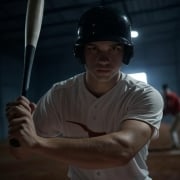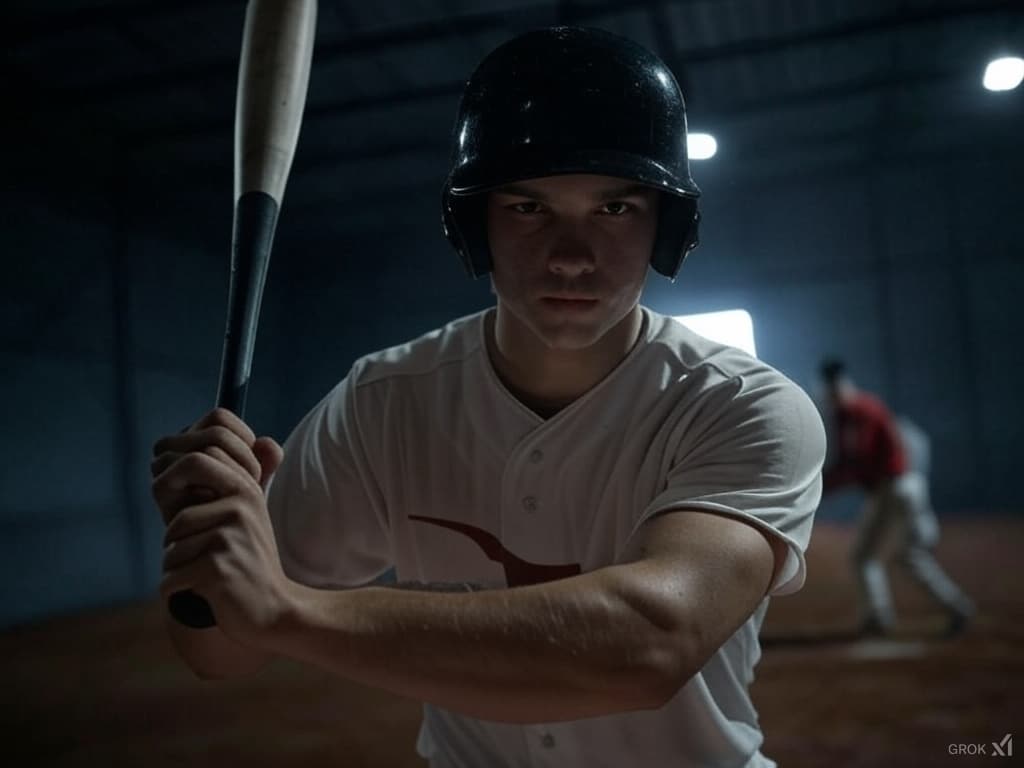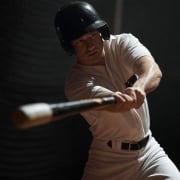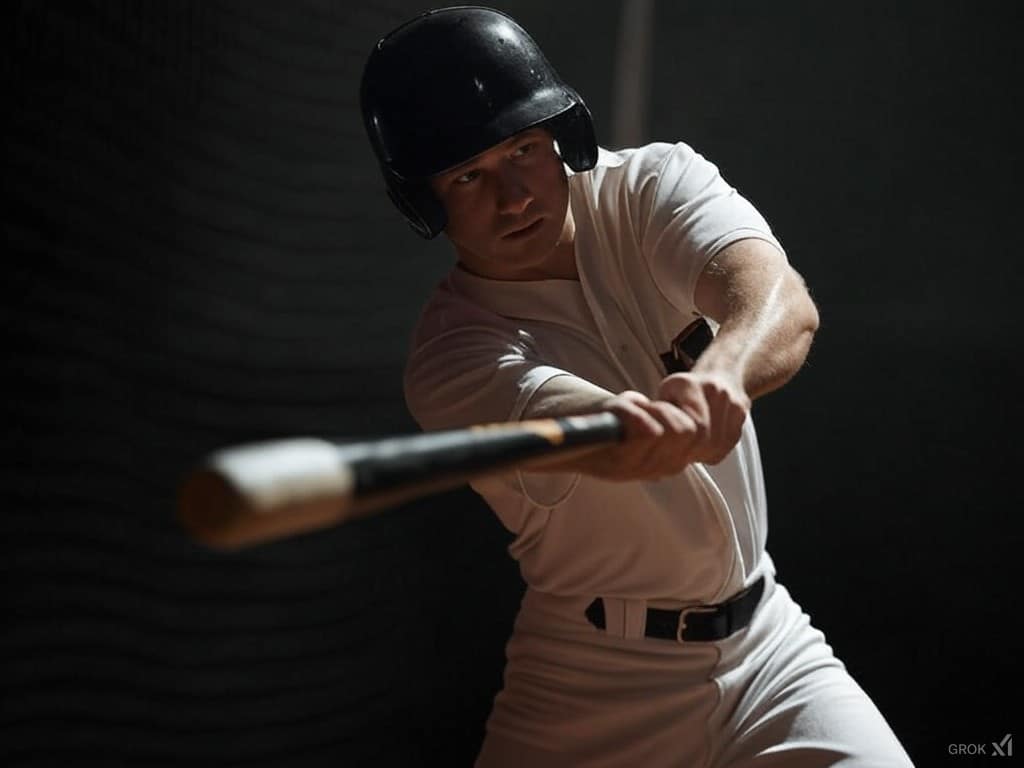
Swing Harder, Hurt More? Why Power Hitters Are Prone to Wrist Injuries (And How to Stop It)
Did you know that 46% of sports injuries occur during forceful swings, often affecting the wrist? This can seriously hinder your performance, whether you’re on the field or in the gym. If you’ve ever felt that sharp discomfort or stiffness, you know how it can throw off your game.
At Hitting Performance Lab, we’ve seen how wrist issues can slow you down. But here’s the good news: with the right mobility drills and strength exercises, you can regain control and power. Our science-backed approach ensures you’re not just treating the problem but preventing it from coming back.
Imagine stepping up to the plate with confidence, knowing your wrists are strong and ready to deliver. That’s the goal we’re here to help you achieve. Stick around as we dive into expert tips and drills that will have you swinging pain-free and faster than ever!
Key Takeaways
- Wrist issues can significantly impact sports performance and daily activities.
- Science-backed mobility drills and strength exercises are essential for recovery.
- Hitting Performance Lab offers innovative solutions for pain-free performance.
- Proper treatment can prevent future wrist problems.
- Targeted exercises can boost bat speed and overall power.
Understanding Wrist Pain and Its Impact
From gripping a bat to typing on a keyboard, your wrist plays a pivotal role in daily life. It’s a complex joint that supports countless activities, yet it’s often overlooked until something goes wrong. At Hitting Performance Lab, we’ve seen how even minor issues can disrupt your game or daily routine.
Think about it: how often do you rely on your hand for simple tasks like opening a jar or carrying groceries? Now imagine those tasks becoming painful or impossible. That’s why understanding wrist function is so crucial—it’s not just about sports performance but also about maintaining your quality of life.
The Role of Wrist Function in Daily Life
Your wrist is a powerhouse of mobility and strength. It allows you to swing a bat, throw a ball, or even write a note. But when an injury or chronic condition like arthritis strikes, it can severely limit your abilities. Common issues include sprains, tendonitis, and carpal tunnel syndrome, all of which can cause pain, swelling, and stiffness.
For athletes, wrist health is non-negotiable. A weak or injured wrist can reduce grip strength, slow bat speed, and even lead to long-term damage. But it’s not just athletes who are at risk. Desk workers, musicians, and anyone who performs repetitive tasks can experience similar problems.
Here’s a quick look at how wrist issues can affect different activities:
| Activity | Impact of Wrist Issues |
|---|---|
| Sports (e.g., baseball, tennis) | Reduced grip strength, slower swings, increased risk of injury |
| Daily Tasks (e.g., typing, cooking) | Pain, stiffness, difficulty performing simple actions |
| Chronic Conditions (e.g., arthritis) | Persistent pain, swelling, limited range of motion |
So, how do you know if your wrist is under duress? Common symptoms include pain, swelling, and a tingling sensation. If you’ve noticed these signs, it’s time to take action. At Hitting Performance Lab, we’re here to help you understand the cause of your discomfort and provide science-backed solutions to get you back in the game.
Causes and Common Symptoms of Wrist Pain
Your fingers and thumb are more connected to your wrist than you might think. When discomfort strikes, it’s often a sign of an underlying issue. Let’s break down the main causes and symptoms so you can better understand what’s going on.
Underlying Conditions: Arthritis, Tendonitis, and Ganglion Cysts
Arthritis is a common culprit, especially in older adults. It causes inflammation in the joints, leading to stiffness and pain. Rheumatoid arthritis often targets the wrist, while osteoarthritis can develop from wear and tear.
Tendonitis occurs when tendons become inflamed, usually due to repetitive movements. This can cause sharp pain and limit your range of motion. Similarly, ganglion cysts—fluid-filled lumps—can press on nerves, leading to discomfort.
Recognizing Injury Signs: Swelling, Stiffness, and Tingling
Swelling and stiffness are telltale signs of an issue. If you notice these symptoms, it’s time to take action. Tingling, especially in your fingers, could indicate carpal tunnel syndrome, where a nerve is compressed.
Problems in your thumb or fingers often reflect deeper issues in the wrist. For example, De Quervain’s tenosynovitis causes pain at the base of the thumb, while tendon injuries can radiate discomfort throughout the hand.
Understanding these symptoms empowers you to address the root cause wrist issues before they worsen. Stay tuned as we dive into solutions to keep you pain-free and powerful!
Pro Mobility & Strength Drills to Fix Wrist Pain
Your performance starts with strong, flexible wrists—let’s build them! At Hitting Performance Lab, we’ve designed science-backed drills to help you recover faster and perform better. Whether you’re dealing with stiffness or looking to prevent issues like tunnel syndrome, these exercises are your game-changer.
Essential Warm-Up and Stretching Techniques
Start with dynamic warm-ups to get your joints ready. Simple moves like wrist circles and finger stretches can improve blood flow and reduce swell. Hold each stretch for 10-30 seconds, repeating 2-3 times for maximum flexibility.
For those prone to tunnel syndrome, try the prayer position stretch. Press your palms together in front of your chest and hold for 25 seconds. This helps relieve pressure and keeps your wrists in top condition.
Strength-Building Exercises for Improved Mobility
Strength is key to preventing injuries. Start with the tennis ball squeeze—grip a ball for 5-10 seconds, repeating 10 times. This builds grip strength without straining your joints.
Next, try wrist curls with light weights. Sit with your forearm on a table, palm up, and slowly lift the weight. Perform 3 sets of 10 reps to enhance flexibility and power. Remember, managing your time effectively during these drills ensures consistent progress.
For advanced mobility, incorporate the farmer’s walk. Carry weights over 50-100 feet to improve grip and forearm strength. This exercise is a game-changer for maintaining good condition and preventing future issues.
Ready to take your game to the next level? Check out these wrist mobility drills for more expert tips!
Game-Ready Power: Mobility Drills for Enhanced Bat Speed
Want to unlock your full potential at the plate? It starts with your wrists! At Hitting Performance Lab, we’ve developed dynamic drills that not only reduce discomfort but also skyrocket your bat speed. These exercises are designed to keep you pain-free and game-ready, whether you’re a pro or just starting out.
Dynamic Drills to Boost Bat Speed
Start with resistance band exercises to build strength and flexibility. For example, try the throwing motion drill with a Jaeger band. Perform 3 sets of 8-10 reps to enhance shoulder and wrist mobility. This drill reduces symptoms like tingling and prevents issues like tunnel syndrome.
Next, incorporate the prayer position stretch. Press your palms together and hold for 25 seconds. This relieves pressure and improves flexibility, making it a must-do before any activity.
Integrating Drills into Your Training Routine
Consistency is key! Add these drills to your warm-up or cool-down routine. For example, perform wrist curls with light weights 2-3 times a week. This builds grip strength and prevents the need for surgery down the line.
For advanced athletes, use a splint during recovery to support your wrists. This ensures a smooth transition back to intense training. Remember, these drills aren’t just for recovery—they’re for building explosive power!
Insights from Hitting Performance Lab Experts
Our experts recommend combining mobility work with strength training. For example, the farmer’s walk is a game-changer. Carry weights over 50-100 feet to improve grip and forearm strength. This exercise keeps your wrists in top condition and prevents future issues.
Want more tips? Check out our guide on developing powerful wrist snap for expert insights!
| Drill | Benefits | Reps/Sets |
|---|---|---|
| Throwing Motion Drill | Improves shoulder and wrist mobility | 3 sets of 8-10 reps |
| Prayer Position Stretch | Relieves pressure, enhances flexibility | Hold for 25 seconds |
| Wrist Curls | Builds grip strength, prevents surgery | 2-3 times a week |
| Farmer’s Walk | Boosts grip and forearm strength | 50-100 feet |
This is a video in the Swing Shift series…
Boost your hitting skills with Swing Shift’s science-backed practice system! This program is packed with features to improve hand path stability, timing, and power. Enjoy engaging drills for consistent progress and fun challenges to keep training exciting. Swing Shift is designed to help players succeed at every level.
The Swing Shift platform lets you focus on key mechanics like bat angle, balance, and hand path control. Dive into step-by-step video lessons that cover power, contact, and rhythm, breaking down the science behind a great swing. With personalized feedback and progress tracking, you can refine your technique and watch your results improve.
Whether you’re a youth athlete, high school player, or elite hitter, Swing Shift is trusted by families and coaches everywhere. Master core skills like bat control, weight transfer, and rotational power with drills designed for real game results. Start your journey to hitting greatness with Swing Shift!
Swing Shift’s practice system offers a wide range of tools to elevate your hitting:
- RNT-based drills for real-time correction
- Engaging challenges for competitive practice
- Personalized training goals and skill progression
- Exclusive videos on timing, power, and consistency
- Hands-on feedback to track and improve your swing mechanics
- Trusted by dedicated parents, players, and coaches
Reach your full potential with Swing Shift’s comprehensive practice system. Elevate your hitting with cutting-edge techniques and proven, science-based training.
Effective At-Home Treatments and Remedies
Dealing with discomfort doesn’t have to be complicated—start with these simple at-home remedies! At Hitting Performance Lab, we’ve seen countless athletes and individuals regain control with these science-backed solutions. Whether you’re managing tendonitis or recovering from a ganglion cyst, these strategies can bring immediate relief.
Using Ice, Medication, and Splints for Immediate Relief
Ice packs are your first line of defense. Apply one for 15-20 minutes every hour to reduce swelling and inflammation. This is especially effective for tendonitis and acute injuries. Pair this with over-the-counter medication like ibuprofen, following the dosing guidelines on the label.
Splints are another game-changer. Wearing one at night keeps your joint aligned, reducing pressure on nerves and tendons. This is a proven strategy for managing conditions like ganglion cysts and chronic discomfort.
Self-Care Routines and Rest Strategies
Rest is non-negotiable. Avoid repetitive motions that strain your joint, and take breaks during activities. Incorporate gentle stretches and exercises from our wrist exercises guide to maintain mobility without overexertion.
Here’s a quick breakdown of effective at-home treatments:
| Treatment | Benefits | Usage |
|---|---|---|
| Ice Packs | Reduces swelling and inflammation | 15-20 minutes every hour |
| Medication (e.g., ibuprofen) | Relieves pain and inflammation | Follow label instructions |
| Splints | Keeps joint aligned, reduces pressure | Wear at night or during rest |
If symptoms persist or worsen, it’s time to consult a doctor. Persistent discomfort could indicate a more serious case requiring professional evaluation. At Hitting Performance Lab, we’re here to guide you every step of the way—because your recovery matters!
Preventative Strategies and Ergonomic Adjustments
Preventing wrist issues starts with smart, everyday choices. Whether you’re at work or play, small adjustments can make a big difference. At Hitting Performance Lab, we’ve seen how proper ergonomics and daily habits can keep your joints healthy and pain-free.
Setting Up an Ergonomic Workspace
Your workspace can be a common cause wrist problems if not set up correctly. Start by ensuring your desk and chair are at the right height. Your forearms should rest parallel to the floor, reducing strain on your carpal bones.
Use a wrist rest for your keyboard and mouse to keep your joints in a neutral position. Avoid excessive wrist flexion or extension, as this can lead to inflammation and even disease over time.
Here’s a quick guide to ergonomic adjustments:
| Adjustment | Benefit |
|---|---|
| Desk Height | Reduces strain on shoulders and wrists |
| Wrist Rest | Keeps joints neutral, prevents inflammation |
| Monitor Position | Reduces neck and wrist strain |
Daily Habits to Prevent Wrist Overuse
Small changes in your routine can protect your joints from overuse. Take regular breaks during repetitive tasks to give your wrists a rest. Incorporate stretches like the prayer position to relieve pressure and prevent cyst formation.
Strengthen your wrists with simple exercises like wrist curls or resistance band drills. These not only improve mobility but also reduce the risk of inflammation and other issues.
At Hitting Performance Lab, we recommend these daily habits:
- Take a 5-minute break every hour to stretch and relax.
- Use ergonomic tools like vertical mice to reduce strain.
- Perform wrist exercises 2-3 times a week to maintain strength.
By making these adjustments, you can avoid the common cause wrist problems and keep your joints healthy for years to come!
When to Consult a Professional for Wrist Pain
Ignoring persistent discomfort can lead to long-term damage—know when to act! While many wrist issues can be managed at home, certain symptoms signal the need for professional treatment wrist care. At Hitting Performance Lab, we’ve seen how early intervention can prevent complications and restore full function.
Warning Signs That Require Medical Attention
Persistent numbness or tingling is a red flag. If these symptoms last more than a day, it could indicate nerve compression or cause pain from conditions like carpal tunnel syndrome. Swelling or a noticeable lump, such as a ganglion cyst, also warrants a doctor’s visit.
Here are key warning signs to watch for:
- Persistent numbness or tingling in your fingers or hand.
- Sharp, directional cause pain that doesn’t improve with rest or ice.
- A visible lump or swelling, especially if it’s a ganglion cyst.
- Inability to move your wrist or hand without severe discomfort.
If you experience any of these symptoms, don’t wait—seek professional treatment wrist immediately. Delaying care can lead to chronic issues or even permanent damage.
Finding Expert Guidance and Wrist Specialists
When home remedies fail, it’s time to consult a specialist. Look for professionals with experience in wrist injuries, such as orthopedic surgeons or physical therapists. They can diagnose the root cause pain and recommend targeted treatments, from splints to surgery.
Here’s how to find the right expert:
| Specialist | Expertise | When to Consult |
|---|---|---|
| Orthopedic Surgeon | Hand and wrist injuries, fractures | Severe pain, inability to move wrist |
| Physical Therapist | Rehabilitation, mobility exercises | Persistent numbness, stiffness |
| Rheumatologist | Arthritis, chronic conditions | Swelling, joint pain lasting weeks |
Remember, your wrists are essential—don’t hesitate to seek expert care when needed!
Conclusion
Taking control of your joint health is the first step toward peak performance! At Hitting Performance Lab, we’ve shown how addressing discomfort early can prevent stiffness and long-term issues. Every person’s situation is unique, but most problems share a common cause—overuse or improper care.
When discomfort strikes, immediate action is key. Use ice to reduce swelling and ibuprofen to manage inflammation. These simple steps can make a big difference in your recovery. Remember, the right type of care can keep you in the game!
Keep practicing the drills and tips we’ve shared. Consistency is your best ally in maintaining strength and flexibility. At Hitting Performance Lab, we’re here to guide you every step of the way. Take charge of your health today and unlock your full potential!
FAQ
What are the most common causes of wrist discomfort?
The most frequent culprits include carpal tunnel syndrome, tendonitis, arthritis, and ganglion cysts. Overuse, repetitive motions, or sudden injuries can also lead to discomfort.
How can I tell if my wrist issue is serious?
If you experience persistent swelling, numbness, tingling, or stiffness that doesn’t improve with rest, it’s time to consult a doctor. Severe pain or loss of function are also red flags.
Can wrist exercises really help with mobility and strength?
Absolutely! Targeted drills like wrist stretches, resistance band exercises, and grip strengthening can improve flexibility, reduce stiffness, and enhance overall performance.
What’s the best way to relieve wrist discomfort at home?
Start with ice packs to reduce inflammation, take over-the-counter medication like ibuprofen, and use a splint for support. Rest and gentle stretching can also speed up recovery.
How do I prevent wrist issues during daily activities?
Focus on ergonomic adjustments, like proper keyboard and mouse positioning. Take frequent breaks, avoid repetitive motions, and incorporate wrist-strengthening exercises into your routine.
When should I consider surgery for my wrist problem?
Surgery is typically a last resort for conditions like severe carpal tunnel syndrome or persistent ganglion cysts. Always explore non-invasive treatments first and consult a specialist for guidance.
Can wrist mobility drills improve my bat speed?
Yes! Dynamic drills that focus on wrist flexibility and strength can significantly enhance your bat speed and overall hitting performance. Consistency is key!
What’s the best way to warm up my wrists before training?
Start with gentle stretches, like wrist circles and finger extensions. Gradually increase intensity with resistance exercises to prepare your wrists for the demands of your sport.




















